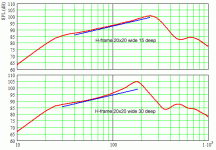Hi
When dealing with h-frames, quarter-wave resonance is a big factor in the design factor.
Why isn't it a factor in horn design? Does the horn expanding design lead to no quarter-wave resonance?
When dealing with h-frames, quarter-wave resonance is a big factor in the design factor.
Why isn't it a factor in horn design? Does the horn expanding design lead to no quarter-wave resonance?
Hi
When dealing with h-frames, quarter-wave resonance is a big factor in the design factor.
Why isn't it a factor in horn design? Does the horn expanding design lead to no quarter-wave resonance?
A properly designed horn, used within its design frequency range, couples to the air such that no standing waves exist within the horn. Of course, in real life some reflections at the mouth do exist, but they can be minimal with good design.
Yes. Let's see it this way: A H-frame is a horn with a very abrupt termination. 🙂Does the horn expanding design lead to no quarter-wave resonance?
But don't forget that in almost all H-frames the 1/4 wavelength resonance peak coincides with the dipole peak. The geometry sort of dictates that. So the overwhelming part of the hump you see in frequency response diagrams of an H-frame is NOT the resonance, but simply the interference pattern between front and back radiation of a dipole.
Rudolf
To clearify: I mean in e.g. a frontloaded jmlc-horn
I cannot see resonances being mentioned as a factor in those kind of designs
I cannot see resonances being mentioned as a factor in those kind of designs
Thanks fpitas and Rudolf 🙂
Can a horny h-frame be utilized higher up in frequence than a normal h-frame? (I am still below the dipole peak)
Can a horny h-frame be utilized higher up in frequence than a normal h-frame? (I am still below the dipole peak)
A horn of any type will have some mouth reflection and hence 1/4 wave (and harmonics) type resonances. By design we want to minimize the mouth reflection and so it is crucial that the horn continues to expand until a fiarly optimal mouth area is reached. I don't know if it is still an ideal design tennant but I saw a paper that made a good case that any horn should expand until the internal flare reached an angle of 45 (I think) degrees relative to the central axis. This was approximately the optimum mouth size.
Now with any straight pipe you have a very low flare rate (0 Hz) and a non optimum mouth area (the same as the throat area), so a 1/4 wave tube (whatever that means) will always be strongly resonant unless heavily damped.
David S.
Now with any straight pipe you have a very low flare rate (0 Hz) and a non optimum mouth area (the same as the throat area), so a 1/4 wave tube (whatever that means) will always be strongly resonant unless heavily damped.
David S.
There is no reason to make the H-frame horny. Keep the frame depth well below the frame width and there should be almost no resonance on the first peak:Can a horny h-frame be utilized higher up in frequence than a normal h-frame? (I am still below the dipole peak)

blue line is the natural 6 dB roll-off of a plain open baffle. The distance between the blue line and the red "peak" is the resonance.
...I saw a paper that made a good case that any horn should expand until the internal flare reached an angle of 45 (I think) degrees relative to the central axis. This was approximately the optimum mouth size.
It depends on the flare. A tractrix for instance would really like tobe taken to at least 90 degrees.
dave
Hi
When dealing with h-frames, quarter-wave resonance is a big factor in the design factor.
Why isn't it a factor in horn design? Does the horn expanding design lead to no quarter-wave resonance?
Actually, the quarter wave resonance is what defines the low frequency corner of nearly any bass horn.
Horns are resonant devices which are damped by an acoustic resistance at each end of the horn.
If those resistances are sufficient and properly sized then there don’t appear to be any resonances.
Normally, that condition is never actually met at low frequencies and so you can see peaks and dips in the frequency response and or the electrical impedance.
Also, while most LF horns are a quarter wavelength long at the low corner, a horn doesn’t reach it’s ideal efficiency until it’s a half wavelength long.
At low frequencies, horn design is dealing with the driver end and mouth end to find an optimal combination for a given size horn.
Best,
Tom Danley
Danley Sound Labs
A fine lady but doesn't say much;
Photos of Danley Sound Labs, Inc. | Facebook
- Status
- Not open for further replies.
- Home
- Loudspeakers
- Multi-Way
- Quarter-wave resonance: h-frame vs horn